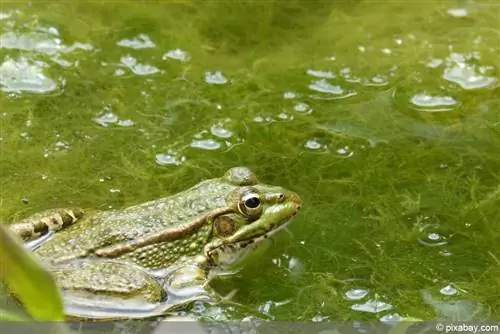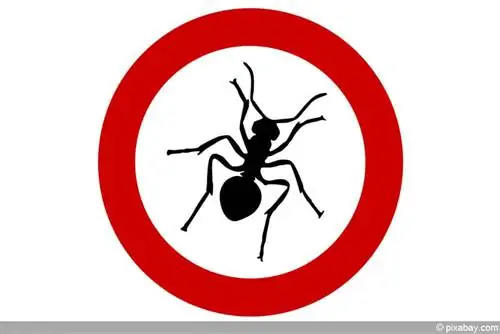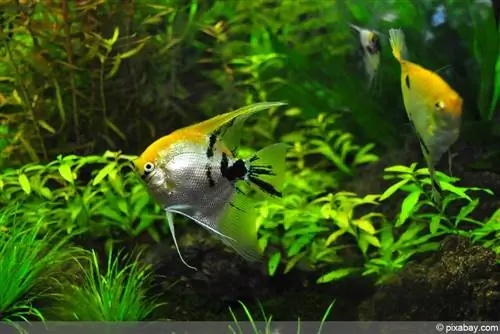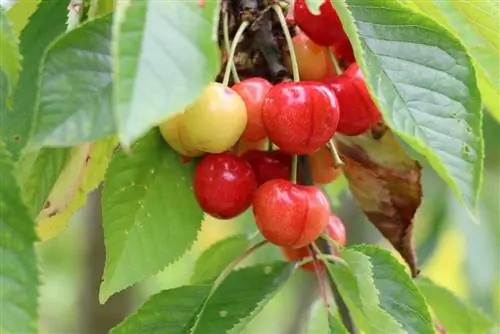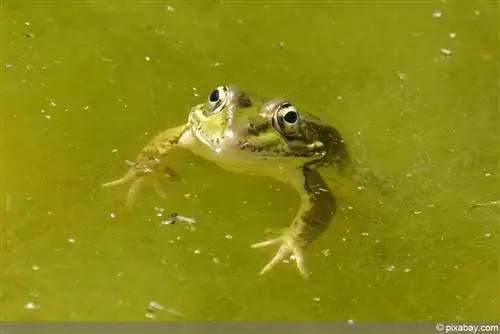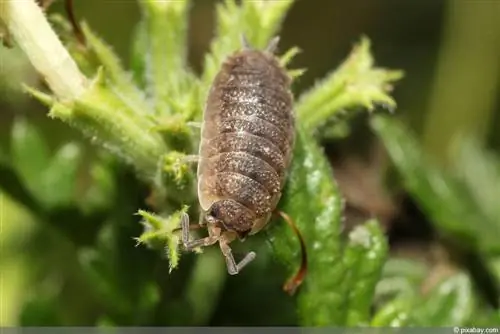- Author admin [email protected].
- Public 2023-12-17 03:39.
- Last modified 2025-06-01 06:48.
Thread algae are green algae. The name says it all, they form long threads and appear even when the water quality is good, often when there is a high supply of nutrients and strong sunlight or strong lighting in the aquarium. Thread algae grows in spring. They can mix with plants and cloud the water considerably. With extreme reproduction, even fish in the pond or aquarium can die.
Causes
Whether in a garden pond or an aquarium, fish promote the growth of algae.
- Excess fish food decomposes in the water. The nutrients promote algae growth
- Fish poop is also a good fertilizer. The more fish, the more nutrients
- Dead parts of plants, both in the pond and in the aquarium
- There is also rain in the pond, which washes in fertilizer and soil
- Leaves can also fall into the pond, decompose over time and release nutrients
- Pond soil also ensures an oversupply of nutrients
Basically the same scenario happens in the garden pond every year. In spring there is a brief algae bloom caused by floating algae. This cannot be prevented and is also part of the pond's self-cleaning process. The mass reproduction of algae means that the available nutrients, mainly phosphates and nitrates, are used up. When the food is largely used up, the floating algae die. The water becomes clear again.
Solutions
If this doesn't work naturally, it's enough to pump the pond water through a suitable UV-C lamp. This causes floating algae to clump together and are caught by the pond filter. The water is now clear, which has more than just advantages. The sun can now penetrate to the bottom of the pond, causing the filamentous algae to begin to multiply. This happens extremely quickly. Thread algae settle everywhere and can become a real nuisance. To get rid of them, consistent fishing and the removal of nutrients helps. This can be achieved in different ways.
Fishing thread algae
The easiest thing to do is to fish out the algae. This works pretty well with a broom handle. You simply drag it through the water, from left to right and vice versa. The long thread-like algae simply wrap around the stem and can therefore be easily removed. The smaller ones can be fished out at the end with a landing net or net. Algae are easy to compost, so don't throw them away!
Water change
Regular water changes can work wonders. However, around 30 percent of the water volume should be replaced, which is a lot for large ponds. It is important that the water is changed at regular intervals. This is of course easier with an aquarium than with a garden pond, but it is important for both bodies of water. It is not clear whether rain or tap water is better. The scholars argue about this. Some say rainwater is too acidic, others say tap water is too rich in nutrients, which encourages algal blooms. What is certain is that not all water is the same. Depending on where you live and where the drinking water comes from, the quality can vary greatly. Well water is usually too high in phosphates. You should definitely have the water quality tested.
Fast-growing aquatic plants
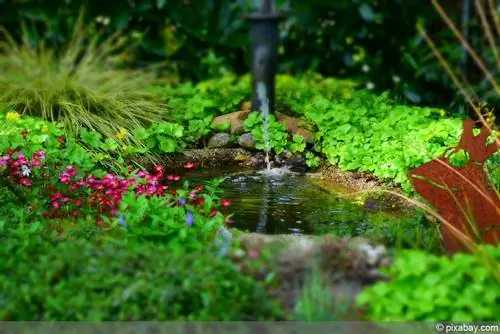
Fast-growing aquatic plants consume a lot of nutrients. These are no longer available to the algae. Below I have put together some plants that grow quickly. Not all of them are hardy, so they have to be removed from the pond and overwintered in the aquarium. Water lilies, which are so popular for ponds, are not among the crops that are important for the biological balance in the pond. They're just beautiful, but that's also a plus. Another advantage of aquatic plants is that they shade the water, especially floating plants and high edge plants that provide shade.
- hornleaf (hornwort)
- Waterplague
- ground nettle
- crab scissors
- Brazilian Milfoil
- Fir fronds
- Mexican Oak Leaf
- Small duckweed
- Water Hyacinth
- Floating rice
- Water lily clover fern
- Shell Flower
- Tufted Fern
- European frogbite
- Floating Spurge
Tip:
The combination of fast-growing aquatic plants and water changes is ideal. This removes a lot of algae. Algae-eating fish and invertebrates take care of the rest.
Reduce nutrients
Thread algae can be starved. You have to deprive them of nutrients. There are various options for doing this.
1. Shade the water surface, at least a third
- Above and underwater plants
- Sun sail
The plants not only provide shade, they also provide oxygen in the water. They also consume nutrients, mainly phosphate and nitrate. Water hyacinths are ideal for water purification.
2. Phosphate bond
Algae growth stops when there is no longer enough phosphate. Unfortunately, very low values are enough for them. Well water is often particularly high in phosphate. It is therefore recommended to have well water tested. There are special phosphate binders to bind phosphate. These last for around two months, leaving little food for the algae. Quite a lot is needed. Success occurs after about two weeks, because this is how long filamentous algae survive without food. It is best to use the phosphate binder in the filter from autumn until spring. During this time, the pond plants do not grow and do not absorb food.
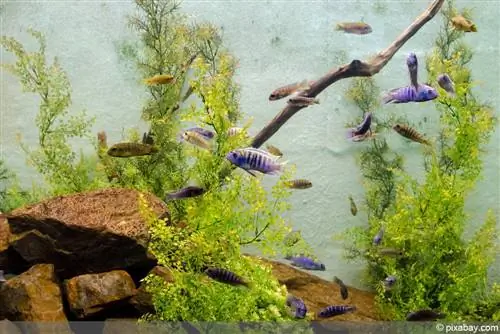
Tip:
There are different phosphate binders, not all of them are natural.
3. Bacteria
Certain bacteria are able to convert the nutrients phosphate and nitrate and make them usable for other organisms. If the overall conditions are right, the algae can be starved. The bacterial mixture Ema lactic acid bacteria from Emiko was tested. A suitable sugar cane molasses nutrient solution was also used.
The bacterial mixture is propagated according to the instructions and is ready for use after 7 days. You can simply add the liquid to the water or the filter. The bacteria activate biological degradation. Appropriate temperatures are crucial, they have to be around 20°C, not too warm, not too cold. The nice thing is that the bacteria are completely harmless to humans, animals and plants. It is important that there is enough oxygen, because the bacteria use a lot of it while working.
4. Algae powder
There are also differences in the algae powders. A natural remedy is, for example, one based on salicylic acid. The product needs to be used about twice a month. It removes the nutrients from the water. Overdose is not harmful.
Do not use algae powder with copper sulfate. This can cause great long-term damage to water bodies, even if the packaging says: “Harmless to animals and plants”.
5. Regular pond care
Pond care includes, for example, quickly fishing off the leaves that land on the surface of the water in autumn so that they cannot sink to the bottom. There it decomposes and lots of nutrients are released, which are then available to the algae in spring. It is best to stretch a net over the pond to prevent the leaves from getting in.
In addition, dead plant residues from the pond plants must also be removed regularly. This affects the plants in and around the pond. Dead animals also provide tons of nutrients, so remove them as quickly as possible.
Prevent nutrient input - Prevention
Prevention is better than cure. Not that many nutrients should get into the pond in the first place. This cannot be completely avoided, but the measures make a huge difference.
- Pay attention to the location of the pond when planning. There should be no deciduous trees or bushes in the immediate vicinity, even if they provide good shade. Instead, choose evergreen trees or provide artificial shade, e.g. with an awning
- Create a pond so that rain cannot wash soil into the pond
- Do not use soil in the pond, preferably no pond soil either. Simply place plants between stones, pebbles or similar.
- Many floating plants also shade the pond well and grow without any substrate, they just float on the surface of the water
- Nevertheless, still plant a lot of plants at the edge of the water, they improve the water quality immensely and are food competitors for the algae
- Remove dead plants regularly
- Without fish, the biological balance is much easier to maintain
- If there are fish in the pond, then only a few
- Fish off leaves regularly. It should not sink to the bottom where it will rot and release nutrients. It is best to cover the pond with a net in autumn.
- Skim off dead algae; when they decompose, lots of nutrients are produced again
- Install pond filter
Conclusion
Algae are something natural. An algae-free pond or an algae-free aquarium, on the other hand, is not natural. It is important to find the golden mean. Nobody probably has anything against a certain number of filamentous algae, they just shouldn't multiply in large numbers. Although it is easier to pour some kind of agent into the pond than to laboriously fish out algae and change the water frequently, there is no more natural way to keep the pond or aquarium clean.
The basic requirement for finding out why there are too many algae in the water is a precise water analysis. This must be carried out in a suitable laboratory. There you can often get tips on what needs to be improved and how to achieve it.
Anyone who intervenes heavily in the cycle of nature should not be surprised if the natural balance tips over. Unfortunately, many anti-algae products that are labeled as fish and plant friendly are not. Many users have already had this painful experience, others will do so. Providing clean water, of course, is safer, although more labor-intensive. Lots of plants in the water, few fish, don't feed much, fish out algae and change the water, in most cases nothing more is necessary.

